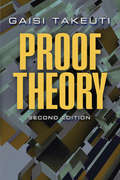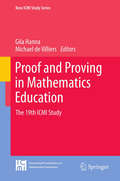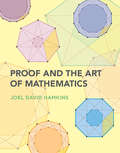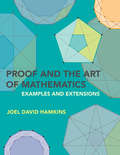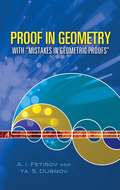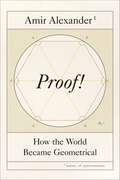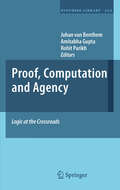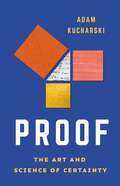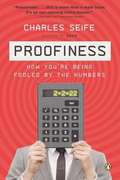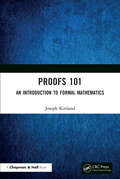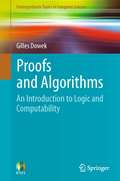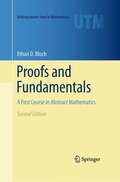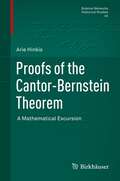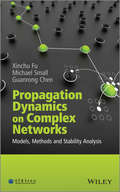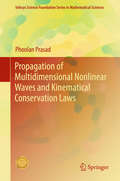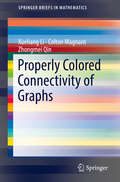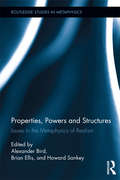- Table View
- List View
Proof Theory: Second Edition (Dover Books on Mathematics #Volume 81)
by Gaisi TakeutiFocusing on Gentzen-type proof theory, this volume presents a detailed overview of creative works by author Gaisi Takeuti and other twentieth-century logicians. The text explores applications of proof theory to logic as well as other areas of mathematics. Suitable for advanced undergraduates and graduate students of mathematics, this long-out-of-print monograph forms a cornerstone for any library in mathematical logic and related topics.The three-part treatment begins with an exploration of first order systems, including a treatment of predicate calculus involving Gentzen's cut-elimination theorem and the theory of natural numbers in terms of Gödel's incompleteness theorem and Gentzen's consistency proof. The second part, which considers second order and finite order systems, covers simple type theory and infinitary logic. The final chapters address consistency problems with an examination of consistency proofs and their applications.
Proof Theory: Sequent Calculi and Related Formalisms (Discrete Mathematics and Its Applications)
by Katalin BimboAlthough sequent calculi constitute an important category of proof systems, they are not as well known as axiomatic and natural deduction systems. Addressing this deficiency, Proof Theory: Sequent Calculi and Related Formalisms presents a comprehensive treatment of sequent calculi, including a wide range of variations. It focuses on sequent calculi
Proof and Proving in Mathematics Education
by Gila Hanna Michael De VilliersOne of the most significant tasks facing mathematics educators is to understand the role of mathematical reasoning and proving in mathematics teaching, so that its presence in instruction can be enhanced. This challenge has been given even greater importance by the assignment to proof of a more prominent place in the mathematics curriculum at all levels. Along with this renewed emphasis, there has been an upsurge in research on the teaching and learning of proof at all grade levels, leading to a re-examination of the role of proof in the curriculum and of its relation to other forms of explanation, illustration and justification. This book, resulting from the 19th ICMI Study, brings together a variety of viewpoints on issues such as: The potential role of reasoning and proof in deepening mathematical understanding in the classroom as it does in mathematical practice. The developmental nature of mathematical reasoning and proof in teaching and learning from the earliest grades. The development of suitable curriculum materials and teacher education programs to support the teaching of proof and proving.The book considers proof and proving as complex but foundational in mathematics. Through the systematic examination of recent research this volume offers new ideas aimed at enhancing the place of proof and proving in our classrooms.
Proof and Proving in Mathematics Education: The 19th ICMI Study (New ICMI Study Series #15)
by Gila Hanna Michael De Villiers*THIS BOOK WILL SOON BECOME AVAILABLE AS OPEN ACCESS BOOK*One of the most significant tasks facing mathematics educators is to understand the role of mathematical reasoning and proving in mathematics teaching, so that its presence in instruction can be enhanced. This challenge has been given even greater importance by the assignment to proof of a more prominent place in the mathematics curriculum at all levels.Along with this renewed emphasis, there has been an upsurge in research on the teaching and learning of proof at all grade levels, leading to a re-examination of the role of proof in the curriculum and of its relation to other forms of explanation, illustration and justification. This book, resulting from the 19th ICMI Study, brings together a variety of viewpoints on issues such as: The potential role of reasoning and proof in deepening mathematical understanding in the classroom as it does in mathematical practice. The developmental nature of mathematical reasoning and proof in teaching and learning from the earliest grades. The development of suitable curriculum materials and teacher education programs to support the teaching of proof and proving.The book considers proof and proving as complex but foundational in mathematics. Through the systematic examination of recent research this volume offers new ideas aimed at enhancing the place of proof and proving in our classrooms.
Proof and the Art of Mathematics: Examples And Extensions
by Joel David HamkinsAn introduction to writing proofs, presented through compelling mathematical statements with interesting elementary proofs.This book offers an introduction to the art and craft of proof-writing. The author, a leading research mathematician, presents a series of engaging and compelling mathematical statements with interesting elementary proofs. These proofs capture a wide range of topics, including number theory, combinatorics, graph theory, the theory of games, geometry, infinity, order theory, and real analysis. The goal is to show students and aspiring mathematicians how to write proofs with elegance and precision.
Proof and the Art of Mathematics: Examples and Extensions
by Joel David HamkinsHow to write mathematical proofs, shown in fully-worked out examples.This is a companion volume Joel Hamkins's Proof and the Art of Mathematics, providing fully worked-out solutions to all of the odd-numbered exercises as well as a few of the even-numbered exercises. In many cases, the solutions go beyond the exercise question itself to the natural extensions of the ideas, helping readers learn how to approach a mathematical investigation. As Hamkins asks, "Once you have solved a problem, why not push the ideas harder to see what further you can prove with them?" These solutions offer readers examples of how to write a mathematical proofs. The mathematical development of this text follows the main book, with the same chapter topics in the same order, and all theorem and exercise numbers in this text refer to the corresponding statements of the main text.
Proof in Geometry: With "Mistakes in Geometric Proofs" (Dover Books on Mathematics)
by A. I. Fetisov Ya. S. DubnovThis single-volume compilation of two books explores the construction of geometric proofs. In addition to offering useful criteria for determining correctness, it presents examples of faulty proofs that illustrate common errors. High-school geometry is the sole prerequisite.Proof in Geometry, the first in this two-part compilation, discusses the construction of geometric proofs and presents criteria useful for determining whether a proof is logically correct and whether it actually constitutes proof. It features sample invalid proofs, in which the errors are explained and corrected.Mistakes in Geometric Proofs, the second book in this compilation, consists chiefly of examples of faulty proofs. Some illustrate mistakes in reasoning students might be likely to make, and others are classic sophisms. Chapters 1 and 3 present the faulty proofs, and chapters 2 and 4 offer comprehensive analyses of the errors.
Proof!: How the World Became Geometrical
by Amir AlexanderA “lucid and convincingly argued” narrative of how ancient geometric principles continue to shape the contemporary world (Publishers Weekly).On a cloudy day in 1413, a balding young man stood at the entrance to the Cathedral of Florence, facing the ancient Baptistery across the piazza. As puzzled passers-by looked on, he raised a small painting to his face, then held a mirror in front of the painting. Few at the time understood what he was up to; even he barely had an inkling of what was at stake. But on that day, the master craftsman and engineer Filippo Brunelleschi would prove that the world and everything within it was governed by the ancient science of geometry.In Proof!, the award-winning historian Amir Alexander traces the path of the geometrical vision of the world as it coursed its way from the Renaissance to the present, shaping our societies, our politics, and our ideals. Geometry came to stand for a fixed and unchallengeable universal order, and kings, empire-builders, and even republican revolutionaries would rush to cast their rule as the apex of the geometrical universe. For who could doubt the right of a ruler or the legitimacy of a government that drew its power from the immutable principles of Euclidean geometry?From the elegant terraces of Versailles to the broad avenues of Washington, DC, and on to the boulevards of New Delhi and Manila, the geometrical vision was carved into the landscape of modernity. Euclid, Alexander shows, made the world as we know it possible.
Proof, Computation and Agency
by Johan Van Benthem Amitabha Gupta Rohit ParikhProof, Computation and Agency: Logic at the Crossroads provides an overview of modern logic and its relationship with other disciplines. As a highlight, several articles pursue an inspiring paradigm called 'social software', which studies patterns of social interaction using techniques from logic and computer science. The book also demonstrates how logic can join forces with game theory and social choice theory. A second main line is the logic-language-cognition connection, where the articles collected here bring several fresh perspectives. Finally, the book takes up Indian logic and its connections with epistemology and the philosophy of science, showing how these topics run naturally into each other.
Proof: The Art and Science of Certainty
by Adam KucharskiAn award-winning mathematician—he "made me smile and made me feel clever" (Peter Frankopan)—shows how we prove what&’s true, and what to do when we can&’t How do we establish what we believe? And how can we be certain that what we believe is true? And how do we convince other people that it is true? For thousands of years, from the ancient Greeks to the Arabic golden age to the modern world, science has used different methods—logical, empirical, intuitive, and more—to separate fact from fiction. But it all had the same goal: find perfect evidence and be rewarded with universal truth. As mathematician Adam Kucharski shows, however, there is far more to proof than axioms, theories, and laws: when demonstrating that a new medical treatment works, persuading a jury of someone&’s guilt, or deciding whether you trust a self-driving car, the weighing up of evidence is far from simple. To discover proof, we must reach into a thicket of errors and biases and embrace uncertainty—and never more so than when existing methods fail. Spanning mathematics, science, politics, philosophy, and economics, this book offers the ultimate exploration of how we can find our way to proof—and, just as importantly, of how to go forward when supposed facts falter.
Proofiness
by Charles SeifeThe bestselling author of Zero shows how mathematical misinformation pervades-and shapes-our daily lives. According to MSNBC, having a child makes you stupid. You actually lose IQ points. Good Morning America has announced that natural blondes will be extinct within two hundred years. Pundits estimated that there were more than a million demonstrators at a tea party rally in Washington, D. C. , even though roughly sixty thousand were there. Numbers have peculiar powers-they can disarm skeptics, befuddle journalists, and hoodwink the public into believing almost anything. "Proofiness," as Charles Seife explains in this eye-opening book, is the art of using pure mathematics for impure ends, and he reminds readers that bad mathematics has a dark side. It is used to bring down beloved government officials and to appoint undeserving ones (both Democratic and Republican), to convict the innocent and acquit the guilty, to ruin our economy, and to fix the outcomes of future elections. This penetrating look at the intersection of math and society will appeal to readers of Freakonomics and the books of Malcolm Gladwell. .
Proofiness
by Charles SeifeThe bestselling author of Zero shows how mathematical misinformation pervades-and shapes-our daily lives. According to MSNBC, having a child makes you stupid. You actually lose IQ points. Good Morning America has announced that natural blondes will be extinct within two hundred years. Pundits estimated that there were more than a million demonstrators at a tea party rally in Washington, D.C., even though roughly sixty thousand were there. Numbers have peculiar powers-they can disarm skeptics, befuddle journalists, and hoodwink the public into believing almost anything. "Proofiness," as Charles Seife explains in this eye-opening book, is the art of using pure mathematics for impure ends, and he reminds readers that bad mathematics has a dark side. It is used to bring down beloved government officials and to appoint undeserving ones (both Democratic and Republican), to convict the innocent and acquit the guilty, to ruin our economy, and to fix the outcomes of future elections. This penetrating look at the intersection of math and society will appeal to readers of Freakonomics and the books of Malcolm Gladwell.
Proofs 101: An Introduction to Formal Mathematics
by Joseph KirtlandProofs 101: An Introduction to Formal Mathematics serves as an introduction to proofs for mathematics majors who have completed the calculus sequence (at least Calculus I and II) and a first course in linear algebra. The book prepares students for the proofs they will need to analyze and write the axiomatic nature of mathematics and the rigors of upper-level mathematics courses. Basic number theory, relations, functions, cardinality, and set theory will provide the material for the proofs and lay the foundation for a deeper understanding of mathematics, which students will need to carry with them throughout their future studies. Features Designed to be teachable across a single semester Suitable as an undergraduate textbook for Introduction to Proofs or Transition to Advanced Mathematics courses Offers a balanced variety of easy, moderate, and difficult exercises
Proofs and Algorithms
by Gilles DowekLogic is a branch of philosophy, mathematics and computer science. It studies the required methods to determine whether a statement is true, such as reasoning and computation. Proofs and Algorithms: Introduction to Logic and Computability is an introduction to the fundamental concepts of contemporary logic - those of a proof, a computable function, a model and a set. It presents a series of results, both positive and negative, - Church's undecidability theorem, Gödel's incompleteness theorem, the theorem asserting the semi-decidability of provability - that have profoundly changed our vision of reasoning, computation, and finally truth itself. Designed for undergraduate students, this book presents all that philosophers, mathematicians and computer scientists should know about logic.
Proofs and Fundamentals: A First Course in Abstract Mathematics
by Ethan D. BlochProofs and Fundamentals: A First Course in Abstract Mathematics” 2nd edition is designed as a "transition" course to introduce undergraduates to the writing of rigorous mathematical proofs, and to such fundamental mathematical ideas as sets, functions, relations, and cardinality. The text serves as a bridge between computational courses such as calculus, and more theoretical, proofs-oriented courses such as linear algebra, abstract algebra and real analysis. This 3-part work carefully balances Proofs, Fundamentals, and Extras. Part 1 presents logic and basic proof techniques; Part 2 thoroughly covers fundamental material such as sets, functions and relations; and Part 3 introduces a variety of extra topics such as groups, combinatorics and sequences. A gentle, friendly style is used, in which motivation and informal discussion play a key role, and yet high standards in rigor and in writing are never compromised.
Proofs and Refutations
by John Worrall Elie Zahar Imre Lakatos Lakatos Imre Zahar ElieImre Lakatos's Proofs and Refutations is an enduring classic, which has never lost its relevance. Taking the form of a dialogue between a teacher and some students, the book considers various solutions to mathematical problems and, in the process, raises important questions about the nature of mathematical discovery and methodology. Lakatos shows that mathematics grows through a process of improvement by attempts at proofs and critiques of these attempts, and his work continues to inspire mathematicians and philosophers aspiring to develop a philosophy of mathematics that accounts for both the static and the dynamic complexity of mathematical practice. With a specially commissioned Preface written by Paolo Mancosu, this book has been revived for a new generation of readers.
Proofs and Refutations
by John Worrall Elie ZaharProofs and Refutations is essential reading for all those interested in the methodology, the philosophy and the history of mathematics. Much of the book takes the form of a discussion between a teacher and his students. They propose various solutions to some mathematical problems and investigate the strengths and weaknesses of these solutions. Their discussion (which mirrors certain real developments in the history of mathematics) raises some philosophical problems and some problems about the nature of mathematical discovery or creativity. Imre Lakatos is concerned throughout to combat the classical picture of mathematical development as a steady accumulation of established truths. He shows that mathematics grows instead through a richer, more dramatic process of the successive improvement of creative hypotheses by attempts to 'prove' them and by criticism of these attempts: the logic of proofs and refutations.
Proofs of the Cantor-Bernstein Theorem
by Arie HinkisThis book offers an excursion through the developmental area of research mathematics. It presents some 40 papers, published between the 1870s and the 1970s, on proofs of the Cantor-Bernstein theorem and the related Bernstein division theorem. While the emphasis is placed on providing accurate proofs, similar to the originals, the discussion is broadened to include aspects that pertain to the methodology of the development of mathematics and to the philosophy of mathematics. Works of prominent mathematicians and logicians are reviewed, including Cantor, Dedekind, Schröder, Bernstein, Borel, Zermelo, Poincaré, Russell, Peano, the Königs, Hausdorff, Sierpinski, Tarski, Banach, Brouwer and several others mainly of the Polish and the Dutch schools. In its attempt to present a diachronic narrative of one mathematical topic, the book resembles Lakatos' celebrated book Proofs and Refutations. Indeed, some of the observations made by Lakatos are corroborated herein. The analogy between the two books is clearly anything but superficial, as the present book also offers new theoretical insights into the methodology of the development of mathematics (proof-processing), with implications for the historiography of mathematics.
Propagation Dynamics on Complex Networks
by Michael Small Guanrong Chen Xinchu FuExplores the emerging subject of epidemic dynamics on complex networks, including theories, methods, and real-world applicationsThroughout history epidemic diseases have presented a serious threat to human life, and in recent years the spread of infectious diseases such as dengue, malaria, HIV, and SARS has captured global attention; and in the modern technological age, the proliferation of virus attacks on the Internet highlights the emergent need for knowledge about modeling, analysis, and control in epidemic dynamics on complex networks. For advancement of techniques, it has become clear that more fundamental knowledge will be needed in mathematical and numerical context about how epidemic dynamical networks can be modelled, analyzed, and controlled. This book explores recent progress in these topics and looks at issues relating to various epidemic systems.Propagation Dynamics on Complex Networks covers most key topics in the field, and will provide a valuable resource for graduate students and researchers interested in network science and dynamical systems, and related interdisciplinary fields.Key Features:Includes a brief history of mathematical epidemiology and epidemic modeling on complex networks.Explores how information, opinion, and rumor spread via the Internet and social networks.Presents plausible models for propagation of SARS and avian influenza outbreaks, providing a reality check for otherwise abstract mathematical modeling.Considers various infectivity functions, including constant, piecewise-linear, saturated, and nonlinear cases.Examines information transmission on complex networks, and investigates the difference between information and epidemic spreading.
Propagation of Multidimensional Nonlinear Waves and Kinematical Conservation Laws (Infosys Science Foundation Series)
by Phoolan PrasadThis book formulates the kinematical conservation laws (KCL), analyses them and presents their applications to various problems in physics. Finally, it addresses one of the most challenging problems in fluid dynamics: finding successive positions of a curved shock front. The topics discussed are the outcome of collaborative work that was carried out mainly at the Indian Institute of Science, Bengaluru, India. The theory presented in the book is supported by referring to extensive numerical results.The book is organised into ten chapters. Chapters 1–4 offer a summary of and briefly discuss the theory of hyperbolic partial differential equations and conservation laws. Formulation of equations of a weakly nonlinear wavefront and those of a shock front are briefly explained in Chapter 5, while Chapter 6 addresses KCL theory in space of arbitrary dimensions. The remaining chapters examine various analyses and applications of KCL equations ending in the ultimate goal-propagation of a three-dimensional curved shock front and formation, propagation and interaction of kink lines on it.
Proper Generalized Decompositions
by Elías Cueto David González Icíar AlfaroThis book is intended to help researchers overcome the entrance barrier to Proper Generalized Decomposition (PGD), by providing a valuable tool to begin the programming task. Detailed Matlab Codes are included for every chapter in the book, in which the theory previously described is translated into practice. Examples include parametric problems, non-linear model order reduction and real-time simulation, among others. Proper Generalized Decomposition (PGD) is a method for numerical simulation in many fields of applied science and engineering. As a generalization of ProperOrthogonal Decomposition or Principal Component Analysis to an arbitrary numberof dimensions, PGD is able to provide the analyst with very accurate solutionsfor problems defined in high dimensional spaces, parametric problems and evenreal-time simulation.
Properly Colored Connectivity of Graphs (SpringerBriefs in Mathematics)
by Xueliang Li Colton Magnant Zhongmei QinA comprehensive survey of proper connection of graphs is discussed in this book with real world applications in computer science and network security. Beginning with a brief introduction, comprising relevant definitions and preliminary results, this book moves on to consider a variety of properties of graphs that imply bounds on the proper connection number. Detailed proofs of significant advancements toward open problems and conjectures are presented with complete references. Researchers and graduate students with an interest in graph connectivity and colorings will find this book useful as it builds upon fundamental definitions towards modern innovations, strategies, and techniques. The detailed presentation lends to use as an introduction to proper connection of graphs for new and advanced researchers, a solid book for a graduate level topics course, or as a reference for those interested in expanding and further developing research in the area.
Properties of QCD Matter at High Baryon Density
by Xiaofeng Luo Qun Wang Nu Xu Pengfei ZhuangThis book highlights the discussions by renown researchers on questions emerged during transition from the relativistic heavy-ion collider (RHIC) to the future electron ion collider (EIC). Over the past two decades, the RHIC has provided a vast amount of data over a wide range of the center of mass energies. What are the scientific priorities, after RHIC is shut down and turned to the future EIC? What should be the future focuses of the high-energy nuclear collisions? What are thermodynamic properties of quantum chromodynamics (QCD) at large baryon density? Where is the phase boundary between quark-gluon-plasma and hadronic matter at high baryon density? How does one make connections from thermodynamics learned in high-energy nuclear collisions to astrophysical topics, to name few, the inner structure of compact stars, and perhaps more interestingly, the dynamical processes of the merging of neutron stars? While most particle physicists are interested in Dark Matter, we should focus on the issues of Visible Matter! Multiple heavy-ion accelerator complexes are under construction: NICA at JINR (4 ~ 11 GeV), FAIR at GSI (2 ~ 4.9 GeV SIS100), HIAF at IMP (2 ~ 4 GeV). In addition, the heavy-ion collision has been actively discussed at the J-PARC. The book is a collective work of top researchers from the field where some of the above-mentioned basic questions will be addressed. We believe that answering those questions will certainly advance our understanding of the phase transition in early universe as well as its evolution that leads to today's world of nature.
Properties, Powers and Structures: Issues in the Metaphysics of Realism (Routledge Studies in Metaphysics)
by Brian Ellis Alexander Bird Howard SankeyWhile the phrase "metaphysics of science" has been used from time to time, it has only recently begun to denote a specific research area where metaphysics meets philosophy of science—and the sciences themselves. The essays in this volume demonstrate that metaphysics of science is an innovative field of research in its own right. The principle areas covered are: The modal metaphysics of properties: What is the essential nature of natural properties? Are all properties essentially categorical? Are they all essentially dispositions, or are some categorical and others dispositional? Realism in mathematics and its relation to science: What does a naturalistic commitment of scientific realism tell us about our commitments to mathematical entities? Can this question be framed in something other than a Quinean philosophy? Dispositions and their relation to causation: Can we generate an account of causation that takes dispositionality as fundamental? And if we take dispositions as fundamental (and hence not having a categorical causal basis), what is the ontological ground of dispositions? Pandispositionalism: Could all properties be dispositional in nature? Natural kinds: Are there natural kinds, and if so what account of their nature should we give? For example, do they have essences? Here we consider how these issues may be illuminated by considering examples from reals science, in particular biochemistry and neurobiology.
Proportional Representation
by Friedrich PukelsheimThe book offers a rigorous description of the procedures that proportional representation systems use to translate vote counts into seat numbers. Since the methodological analysis is guided by practical needs, plenty of empirical instances are provided and reviewed to motivate the development, and to illustrate the results. Concrete examples, like the 2009 elections to the European Parliament in each of the 27 Member States and the 2013 election to the German Bundestag, are analyzed in full detail. The level of mathematical exposition, as well as the relation to political sciences and constitutional jurisprudence makes this book suitable for special graduate courses and seminars.
